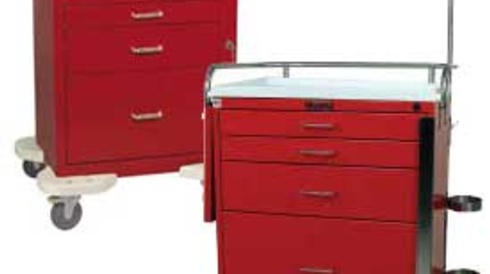![[Image: masthead]](/mhau001/includes/themes/MHAUS_2016/images/masthead/masthead-large.png)
24-HOUR MH HOTLINE: 800-644-9737
Outside NA: 001-209-417-3722
FOR EMERGENCIES ONLY
Outside NA: 001-209-417-3722
FOR EMERGENCIES ONLY
What Should be on an MH Cart?
Drugs
Therapy should be aimed at prompt administration of dantrolene, treatment of hyperkalemia, hyperventilation, and cooling to a target core temperature of no more than 38°C.
- Dantrolene – To treat an MH episode, an initial dose of dantrolene at 2.5 mg/kg is recommended. There are two formulations now available. DANTRIUM®/REVONTO® are the older formulation, which provides 20 mg dantrolene sodium/60 mL after reconstitution in sterile water. The second formulation, RYANODEX® (dantrolene sodium), is a new formulation that is an injectable suspension of dantrolene sodium providing 250 mg of dantrolene sodium/5 mL after reconstitution. RYANODEX® is manufactured by Eagle Pharmaceuticals, Inc. and was approved by the FDA in 2014.
- DANTRIUM®/REVONTO® – 36 vials should be available in each institution where MH can occur, each vial to be diluted at the time of use with 60 ml sterile water, USP (without a bacteriostatic agent). There are 3 grams of mannitol in each vial of 20 mg of dantrolene (0.15 g mannitol/ 1 mg dantrolene).
- RYANODEX® – 3 vials should be available in each institution where MH can occur, each to be diluted at the time of use with 5 ml of sterile water for injection, USP (without a bacteriostatic agent). There are 0.125 grams of mannitol in each vial of 250 mg of Ryanodex® (0.0005 grams mannitol/1 mg dantrolene).
- Sterile water for injection USP (without a bacteriostatic agent) – It is mandatory to get dantrolene sodium to its effective site, the skeletal muscle.
- DANTRIUM®/REVONTO® – Each 20 mg vial should be reconstituted by adding 60 ml* of sterile water for injection, USP (without a bacteriostatic agent) and the vial shaken until the solution is clear. If the MH episode is proceeding rapidly, simply mix and inject. We advise that the sterile water be stored in 100 ml vials, not bags, to avoid accidental IV administration of this hypotonic solution. * Click here to see a list of Vendors for 60 mL syringes
- RYANODEX® – Each 250 mg vial should be reconstituted with 5 ml of sterile water for injection, USP (without a bacteriostatic agent) and shaken to ensure an orange-colored uniform, opaque suspension. RYANODEX® should be administered by intravenous push. Five percent dextrose injection, USP, 0.9% sodium chloride injection, USP, and other acidic solutions are NOT compatible with RYANODEX® and should not be used. The contents of the vial must be used within 6 hours after reconstitution.
- Sodium bicarbonate (8.4%) – 50 ml x 4
- Dextrose 50% – 50 ml vials x 2
- Calcium chloride (10%) – 10 ml vial x 2
- Regular insulin – 100 units/ml x 1 (refrigerated)
- Lidocaine* for injection (2%) – 100 mg/5 ml or 100 mg/10 ml in preloaded syringes (3). Amiodarone is also acceptable. ACLS protocols, as prescribed by the AHA, would be followed when treating all cardiac derangements caused by MH.
- Refrigerated cold saline solution – A minimum of 3,000 ml for IV cooling
* Lidocaine or procainamide should not be given if a wide-QRS complex arrhythmia is likely due to hyperkalemia; this may result in asystole.
General Equipment
- Charcoal Filters - Two pairs of activated charcoal filters (Vapor-Clean™, Dynasthetics, Salt Lake City, UT). Attach activated charcoal filters to inspiratory and expiratory ports of the anesthesia machine to quickly reduce the concentration of gas (<5ppm) from the anesthesia machine. In this situation, even though the anesthetic gas has been discontinued when MH was first suspected, the Vapor-Clean™ filter may become saturated after one hour; therefore, a replacement set of filters should be substituted after each hour of use.
- Syringes – (60 ml x 5) to dilute Dantrium®/Revonto® and (5 ml x 3) for Ryanodex®
- Intravenous catheters – 16G, 18G, 20G, 2-inch; 22G, 1-inch; 24G, 3/4-inch (4 each) (for IV access and arterial line)
- Pressure Bag
- Disposable Cold Packs - (x 4)
Monitoring Equipment
- Esophageal or other core (e.g., nasopharyngeal, tympanic membrane, rectal, bladder, pulmonary artery catheter) temperature probes
- CVP kits (sizes appropriate to your patient population). We recommend these are used in patients who are critically ill.
- Transducer kits for arterial and central venous cannulation
Nursing Supplies
- Large sterile Steri-Drape (for rapid drape of wound)
- Urine meter x 1
- Large clear plastic bags for ice x 4
- Small plastic bags for ice x 4
- Bucket for ice
- Test strips for urine hemoglobin
Laboratory Testing Supplies
- Syringes (3 ml) for blood gas analysis or ABG kits x 6 or point of care monitors; ISTAT with TB syringes (the point of care ISTAT device has replaced lab blood gene and electrolyte measurement).
- Blood specimen tubes for CK, myoglobin, SMA 19 (LDH, electrolytes, thyroid studies), PT/PTT, fibrinogen, fibrin split products; and lactate, CBC, platelets. If no immediate laboratory analysis is available, samples should be kept on ice for later analysis. This may well prove useful on retrospective review and diagnosis. Blood cultures are very useful and should be included to rule out bacteremia.
- Urine collection container for myoglobin level. Pigmenturia (e.g , brown or red urine and heme positive dipstick) indicates that renal protection is mandated, when the urine is centrifuged or allowed to settled, and the sample shows clear supernatant, i.e., the coloration is due to red cells in the sample.
%20with%20wording.jpg) Click here to order the MH Cart Cards
Click here to order the MH Cart Cards
for a list of all supplies recommended by MHAUS to stock an MH cart.
Suggested Use: Hang from your MH Cart for quick reference.
